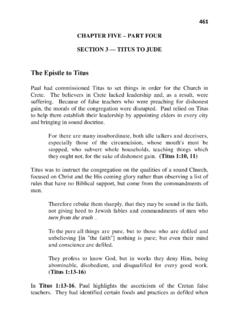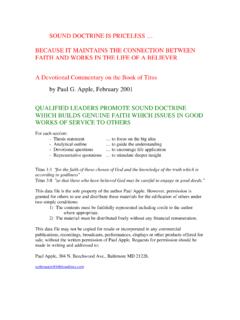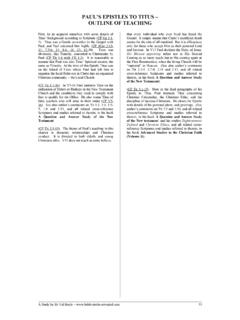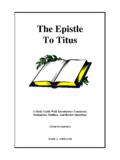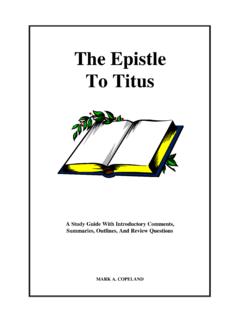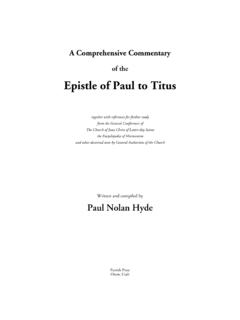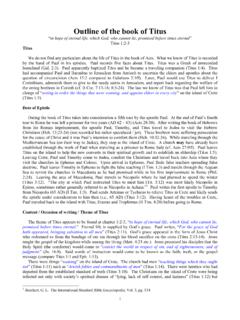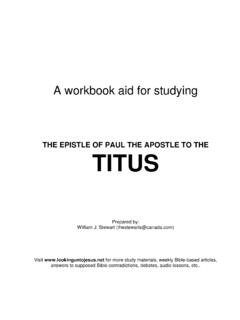Transcription of Discourse Analysis of the Book of Titus - coreykeating
1 Discourse Analysis of the Book of Titus By Corey Keating Professor Tom Parker Directed Study: Advanced Greek Term Paper Fuller Theological Seminary Phoenix Extension Winter Quarter 2003 The New Testament epistle of Titus exhibits a fascinating syntactical structure in its original language, Koine Greek. Does that syntactical structure correspond to the semantic force of the letter? Does the syntax convey the same emphasis as the overall message of the Discourse ? If not, where do they differ or intersect? It will be argued here that the major thrust of the book syntactically is parenetic in nature; it emphasizes Paul s exhortation for Titus to teach sound doctrine and to live a life worthy of that gospel message.
2 What could be considered as the more profound theological points are syntactically subordinate to these imperatival exhortations. However, regarding Discourse and semantics, the content of what Titus is to teach and the outcome it should have on his hearers carries the most weight. Thus from a semantic viewpoint, the letter has strong ethical overtones. The message of the letter for Titus is to preach and teach. The message of the letter for others in the church is that their lives should exhibit good works so as to confirm the sound doctrine of the gospel message.
3 It is not my intention here to give a detailed outline of the book of Titus , but rather to point out the syntactical and Discourse features that give structure to the letter. But in highlighting the patterns of Discourse and the syntactical boundary markers, an overall outline of the book does become apparent. For purposes of this paper, I am taking the letter s introduction at face value and assuming that the Apostle Paul originally wrote the book as a letter to his younger co-worker, Titus , whom he had left on the island of Crete. Although this is not critical for the argument of this paper, it facilitates a less awkward way of referring to the writer and recipient.
4 Furthermore, I am only dealing with the book in its final form, assuming that it was written as one coherent letter and not subsequently collected from various writings. Moreover, I am not considering the impact that textual variants may have on the letter s meaning or structure. Page 2 High Level Structural Elements A New Testament epistle Structurally the book of Titus fits the typical tripartite form of most New Testament epistles, having an introductory salutation, a letter body, and a Like most epistles, Paul s opening salutation to Titus (1:1-4) is characterized by its lack of finite verbal forms.
5 2 (It should be noted that there are indeed two finite verbs in Titus 1:1-4, but they are both in subordinate relative clauses. There is no explicit verb forming an independent clause in these first four verses. In this regard the first four verses are verbless.) The body of the letter thus starts with the first explicit independent verbal clause in Titus 1:5. It ends with the last formal instruction given to Titus in chapter 3, verses 10 and 11. Most of this paper will discuss the material within this section. The last four verses of the book (3:12-15) are set apart as the closing section.
6 Structurally they are separated from the body of the letter by the subordinating conjunction o[tan ( when ), which puts the temporal deixis into the future. Semantically the topic changes to closing instructions and final blessings. Structured According to Time Seen from a different level of overall structure, it is interesting to note the time element in different sections of this letter. After the opening, the body of the letter first talks about actions that took place in the past. It then gives directives concerning Titus present situation and concludes by giving instructions regarding the future.]
7 The first verb in the body of the letter is avpe,lipon ( I left ), which is in the aorist tense. The context helps to clarify the fact that this is a normal use of the aorist indicative, referring to an 1 Cf. David Allen, The Discourse Structure of Philemon: A Study in Textlinguistics . David Alan Black, ed. Scribes and Scripture: New Testament Essays in Honor of J. Harold Greenlee (Winona Lake, Indiana: Eisenbrauns, 1992): 80, 83. 2 Ibid., 83. Page 3 action in the past time. In this section, Paul reminds Titus why he had left him in Crete.
8 He subsequently sent him this letter for exhortation and encouragement. In verse thirteen, Paul then uses the first imperative verb in this letter. At this point the discussion turns from why Titus had been left in Crete to his current assignment and responsibilities in that location. All the imperatives used in the body of the letter are in the present tense. The discussion throughout the entire body of the letter revolves around present instructions for Titus . As mentioned above, the closing section of the letter begins with the subordinating conjunction o[tan ( when ), which puts the time of the statement into the future.]
9 This shift to future time acts as a syntactical boundary. Besides the final greeting, the conclusion to the letter is mainly instructions concerning the future for both Titus and those with him. Syntactical Boundaries and Patterns in Letter s Structure Overview of the Structure A syntactic Analysis of the main body of Titus letter reveals some intriguing patterns of Discourse . (Refer to the Structural Outline below for a visual representation of this material.) It seems that most new sections of Discourse begin with exhortations (1:13b-2:10, 3:1-2, and 3:9a &10) and are followed by sections of explanation or motivation, often providing the theological undergirding for the instruction3 (2:11-14, 3:3-7, and 3:9b & 11).
10 The two sections that make up the majority of the body also include a concluding summary exhortation (2:15 and 3:8). In these sections of exhortation and explanation, there is usually supporting material giving the purpose or reason for the preceding statement. The syntactical thrust of the letter is centered on instructions and exhortations that Paul gives to Titus . These sections begin with 2nd person singular imperative verb forms. As such, the 3 David J. Clark, Discourse Structure in Titus . The Bible Translator, 53, No.
